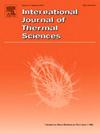盐溶液冻结过程中冰-水界面离子迁移的数值研究
IF 5
2区 工程技术
Q1 ENGINEERING, MECHANICAL
International Journal of Thermal Sciences
Pub Date : 2025-05-24
DOI:10.1016/j.ijthermalsci.2025.110017
引用次数: 0
摘要
本研究运用相场理论,将固液分散的概念引入盐溶液的冷冻过程。为解决盐溶液冻结过程中离子迁移问题,建立并验证了冰-水相变界面传热传质复杂物理过程的数学模型。该模型考虑了冰中盐结晶和离子释放的影响,阐明了相场、温度场和浓度场之间的微观相互作用。结果表明:在相变过程中,主要的换热区域发生在冰-水相变界面,温度扩散层的形成和离子浓度的增加会抑制枝晶的生长;从冰-水界面排出的离子积聚在树突的尖端和根部,导致树突之间的竞争生长,最终发展成盐水通道和盐水袋,导致离子在冰内被重新捕获。在相同的模拟条件下,不同离子的迁移模式与实验研究结果一致,表明所构建的模型能够较准确地描述不同离子在冻结条件下的迁移模式。本文章由计算机程序翻译,如有差异,请以英文原文为准。

Ion migration at the ice–water interface during the freezing process of salt solution – Numerical investigation
This study applies phase-field theory, introducing the concept of solid–liquid dispersion into the freezing process of salt solutions. A mathematical model for the complex physical processes of heat and mass transfer at the ice–water phase transition interface was established and validated to address the issue of ion migration during the freezing process of salt solutions. The model considers the effects of salt crystallization and ion release in ice, elucidating the microinteractions among the phase field, temperature field, and concentration field. The results show that during the phase transition, the main region of heat exchange occurs at the ice-water phase transition interface, and the formation of a temperature diffusion layer and increased ion concentration will inhibit the growth of dendrites. The ions expelled from the ice–water interface accumulate at the tips and roots of the dendrites, leading to competitive growth among dendrites, which eventually develop into saline channels and brine pockets, resulting in ions being recaptured within the ice. Under identical simulation conditions, the migration patterns of different ions are consistent with those obtained from experimental studies, indicating that the constructed model can accurately depict the migration patterns of different ions under freezing conditions.
求助全文
通过发布文献求助,成功后即可免费获取论文全文。
去求助
来源期刊

International Journal of Thermal Sciences
工程技术-工程:机械
CiteScore
8.10
自引率
11.10%
发文量
531
审稿时长
55 days
期刊介绍:
The International Journal of Thermal Sciences is a journal devoted to the publication of fundamental studies on the physics of transfer processes in general, with an emphasis on thermal aspects and also applied research on various processes, energy systems and the environment. Articles are published in English and French, and are subject to peer review.
The fundamental subjects considered within the scope of the journal are:
* Heat and relevant mass transfer at all scales (nano, micro and macro) and in all types of material (heterogeneous, composites, biological,...) and fluid flow
* Forced, natural or mixed convection in reactive or non-reactive media
* Single or multi–phase fluid flow with or without phase change
* Near–and far–field radiative heat transfer
* Combined modes of heat transfer in complex systems (for example, plasmas, biological, geological,...)
* Multiscale modelling
The applied research topics include:
* Heat exchangers, heat pipes, cooling processes
* Transport phenomena taking place in industrial processes (chemical, food and agricultural, metallurgical, space and aeronautical, automobile industries)
* Nano–and micro–technology for energy, space, biosystems and devices
* Heat transport analysis in advanced systems
* Impact of energy–related processes on environment, and emerging energy systems
The study of thermophysical properties of materials and fluids, thermal measurement techniques, inverse methods, and the developments of experimental methods are within the scope of the International Journal of Thermal Sciences which also covers the modelling, and numerical methods applied to thermal transfer.
 求助内容:
求助内容: 应助结果提醒方式:
应助结果提醒方式:


